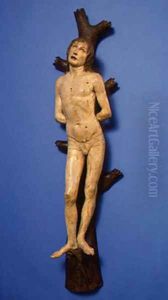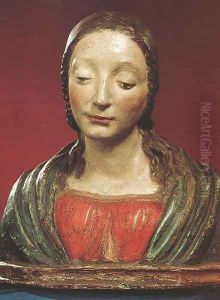Matteo Civitale Paintings
Matteo Civitali was an Italian sculptor and architect who played a significant role in the Early Renaissance period, primarily working in Lucca, his hometown, and the surrounding Tuscany region. Born in 1436 into a family that was not particularly distinguished in the arts, Civitali managed to carve out a significant career for himself through his talent and dedication to his craft. His works are characterized by their delicate beauty, technical skill, and the gentle humanism they exude, reflecting the broader cultural shifts of the Renaissance.
Civitali was trained in Florence, a center of Renaissance art and thought, where he was influenced by the works of Donatello and Luca della Robbia. This influence is evident in his mastery of marble sculpture and his delicate approach to human figures, which often convey a sense of piety and introspection. Returning to Lucca, he became the city's leading sculptor, contributing significantly to its architectural and sculptural landscape. Among his notable works are the marble altarpiece in the Chapel of St. Regulus in the Cathedral of San Martino in Lucca and the serene 'Madonna and Child' sculptures that reflect his deeply religious sensibility.
In addition to his sculptural work, Civitali was involved in architectural projects. He is credited with the design of the façade for the church of San Frediano in Lucca, showcasing his versatility and the high regard in which he was held as an artist. Civitali's work was not only appreciated in his lifetime but also left a lasting legacy in the region, influencing subsequent generations of artists. His dedication to his craft and his ability to imbue his works with a profound sense of humanism and divine beauty make him a noteworthy figure in the history of Italian Renaissance art.
Matteo Civitali passed away in 1501, leaving behind a body of work that continues to be admired for its grace and emotional depth. Through his sculptures and architectural projects, he contributed to the cultural richness of the Renaissance in Italy, reflecting the period's ideals of beauty, humanism, and devotion. His legacy is preserved in the many pieces that survive in Lucca and museums around the world, testament to his skill and artistic vision.

